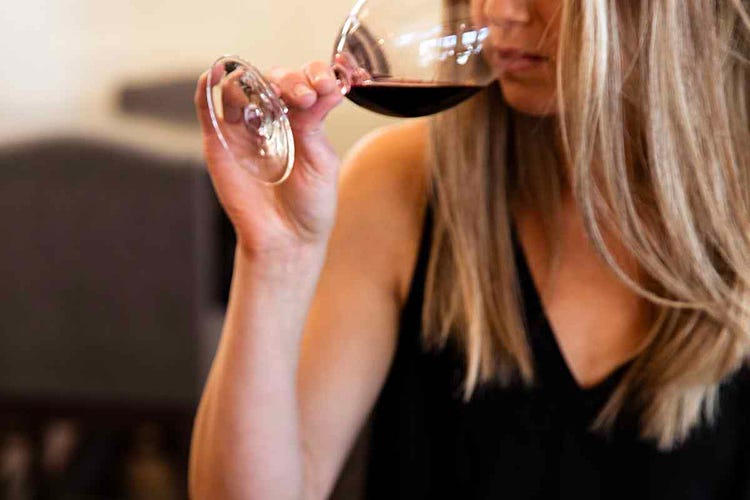Mmm, what's that smell?
We talk about tasting wine, but our sense of smell may actually be the most effective tool we have for fully enjoying our wine. What’s up with that?
Your support matters: I buy the wines I review and don’t accept free samples. Your paid subscriptions make that possible. Please consider subscribing today!
It’s simple, and chances are that you know this already: Most of what we think of as our sense of taste is really in our nose, where we can distinguish among an estimated 10,000 specific aromas.
Our taste buds, on the other hand, are comparatively limited in their ability to sort out a handful of flavors: sweet, sour, salty, bitter, and the more recently defined umami, the Japanese name for that brothy, savory, delicious flavor that makes our mouths water.
But it’s not always easy to name the many beguiling aromas that lift up from our wine glass. We may be enticed by appetizing fruits and flowers, confronted with unexpected aromatics like butter, wood, or wet stones and rainwater, or even shocked by smells that evoke kerosene, horse sweat, used cat litter, or old rubber boots.
Picking out such specific scents can be one of the challenges in wine appreciation, and the good news is that we can train our noses to become better at this task. First and simplest is the old advice the New York cabbie gave when a passenger asked how to get to Carnegie Hall: “Practice, practice, practice.”
Every time you taste a glass of good wine, pause, take a breath, and approach it mindfully. Swirl, sniff, and sniff again, giving your senses and your mind time to recognize aromas and assign names to them. The more regularly you do this, the easier it gets.
Get your nose right into the glass and up close and personal with the wine, suggests Napa Valley’s Baldacci Family Vineyards in Part 2 in its How To Taste Wine series, Swirl and Smell.
But wait! There’s more! For one thing, we know that our sense of smell works not only through our nose but also inside our mouth, through an internal chimney at the back of our palates called the “retro-nasal passage.” In other words, in addition to sniffing the wine with our nose, our sense of smell gets a second, strong impression lofted up to our brain while the wine is in our mouth.
This mechanism, scientists say, likely evolved to give early humans a second line of defense against consuming rotten or spoiled food. But in our kinder, gentler modern times, it gives us another way to enjoyably analyze our wine.
We talk about tasting wine, but our sense of smell may be even more important than our taste buds. What do you think?
Here’s another, less familiar technique that I learned several years ago while listening to an episode on the TED Radio Hour podcast, “Listen Again: Breathe, with host Manoush Zomorodi interviewing scent historian Caro Verbeek.
To fully appreciate a scent, Verbeek said, “You can use this sniffing technique: short, fast inhalations, like a dog – sniff sniff sniff.” What’s more, she said, “It is also important to use both nostrils. Many of us are not aware that one nostril actually perceives something different from the other. No one’s nostrils are equal in power.”
Who knew? Of course I had to try it, and sure enough, much to my surprise, a glass of wine – and just about anything else I tasted – smells perceptibly different when I take four quick sniffs, then close one nostril, sniff, then close the other and do it again. It’s simple, it’s easy, and the benefits in tasting wine analytically are obvious. Try it! I think you’ll enjoy the experiment, and maybe you’ll start doing it whenever you taste.
You couldn’t go wrong by trying this with today’s featured Loire Valley Chenin Blanc, Cosme Grosse Pierre Vouvray.
Since I buy all the wines I review at retail and do not accept wine samples or other gratuities from the industry, I count on the support of paid subscribers to help cover the cost of the wines I review. So, I have to reserve wines that cost me more than about $20 behind our subscription paywall. If you haven’t become a full subscriber yet, I’d love to have your support. Click here for information on our paid-tier edition. Our free-to-all edition featuring a quality wine for $20 or less will return in its biweekly cycle next week.
Support The 30 Second Wine Advisor with your paid-tier subscription. For $5 per month or $50 for a year (a 17% saving), you’ll receive additional wine notes funded by your subscriptions, gain quick direct access through Substack for wine-related questions, and gain my real appreciation for your support.
Keep reading with a 7-day free trial
Subscribe to The 30 Second Wine Advisor to keep reading this post and get 7 days of free access to the full post archives.




